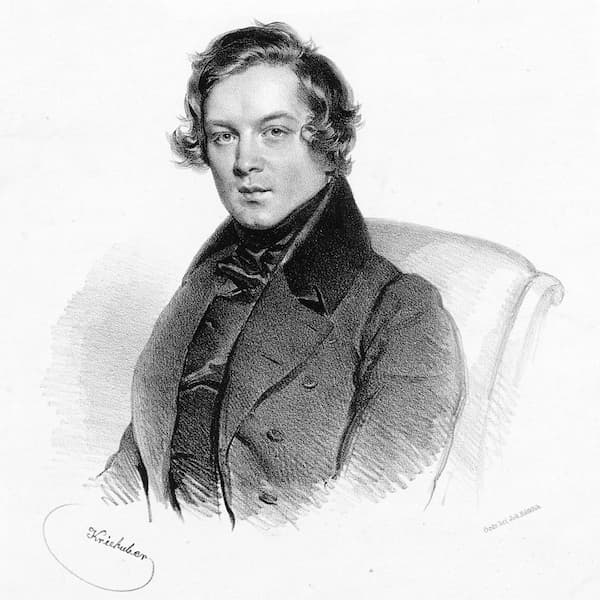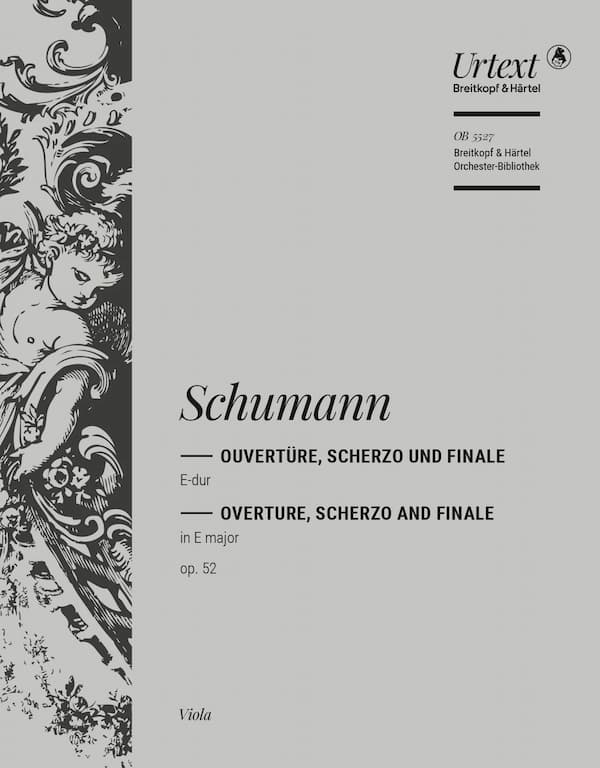Unexpectedly, Schumann’s “Spring Symphony” had been a great success at its first performance under Felix Mendelssohn in 1841. In the wake of this triumph and his marriage to Clara, Schumann decided that an orchestra would “best portray his celebratory feelings.” As such, he went to work on a composition often referred to as “the symphony without a slow movement.” Initially, Schumann called the composition a “Suite,” and later a “Sinfonietta,” but it premiered in Leipzig on December 6, 1841, under the title Overture, Scherzo and Finale.

Robert and Clara Schumann, 1850
In April 1841, Schumann wrote in the joint diary which he kept with Clara, “Began Overture in E.” Five days later the overture was completely and already fully orchestrated. It only took Schumann a couple more days before the Scherzo and the Finale had taken shape. In essence, Schumann had composed the work in merely 3 weeks, and as he wrote, “in a truly merry mood.” As Schumann explained, the principal reason why he refused to call it a symphony was “that the single movements could be played separately.”
Robert Schumann: Overture, Scherzo and Finale, Op. 52 “Overture” (Seattle Symphony Orchestra; Gerard Schwarz, cond.)
Reactions

Josef Kriehuber: Robert Schumann, 1839
In the event, the premiere at a pension-fund concert featuring Clara Schumann and Franz Liszt, did not go well. As Schumann subsequently wrote, “The two orchestral works and an overture, scherzo, and finale, did not receive as much applause as the First Symphony. It was really too much at once, I believe, and then Mendelssohn was missing as the conductor. But that does not hurt anything—I know that the pieces are in no respect inferior to the First Symphony and will be recognised sooner or later in their own way.”
A critic for the AMZ provided more detail, as he writes, “Of the three movements… the overture is without any doubt very lovely, exceptionally well written, delicately and tastefully scored; the scherzo is also interesting, the motives fresh but rather less clearly developed; the final is full of unrest, however, very obscure from the beginning to end and scored without any beneficial colouring, and it is further devoid of prominent, memorable motives and can hardly function advantageously in its present form.”
Robert Schumann: Overture, Scherzo and Finale Op. 52, “Scherzo” (Leipzig Gewandhaus Orchestra; Franz Konwitschny, cond.)
Revisions

Robert Schumann: Overture, Scherzo and Finale, Op. 52 “Overture”
It was clear the work was in need of revision, and he wrote to Mendelssohn on 12 November 1845, “I have changed much in the Overture, Scherzo, and Finale, reworked the latter entirely; it now appears much better to me.” After the revised work was performed on 1 January 1846, Schumann eventually found a publisher in Julius Kistner.
As Jon W. Finson writes, “The chronology for the composition of the Overture, Scherzo and Finale indicates that Schumann actively cultivated public recognition in creating the piece. When audience reaction was unenthusiastic at the premiere, and publishers repeatedly rejected the work, he revised it to enhance its commercial viability.” One thing is for sure: Schumann was convinced of the popular appeal of the composition.
Robert Schumann: Overture, Scherzo and Finale Op. 52, “Finale” (arr. C. and R. Schumann) (Eckerle Piano Duo)
Reception

Robert Schumann: Overture, Scherzo and Finale Op. 52, “Finale”
With the wider oeuvre of Schumann’s orchestral compositions, the Overture, Scherzo and Finale always stood in the shadow of the four symphonies. As a scholar wrote, “to this day, audiences have failed to grasp the work’s inventive concept as a lighter-weight symphony that was easy to understand, lacking a slow movement and consisting of three independent movements that could be played individually.”
The melodies are certainly high-spirited and lyrical throughout, and Schumann employed a comparatively light scoring. The “Overture” is a small-scale sonata form prefaced by a gloomy introduction in the minor key. Two contrasting themes enjoy a jovial conversation, and a brief coda brings this light movement to a close. The dance-like “Scherzo” harkens back to Schumann’s early piano pieces, and the “Finale” brims with contrapuntal confidence. A scholar writes, “Given the freshness of its musical ideas, the tight formal discipline and the relatively transparent orchestration, this piece deserves to be counted among Schumann’s finest orchestral works.”
For more of the best in classical music, sign up for our E-Newsletter
